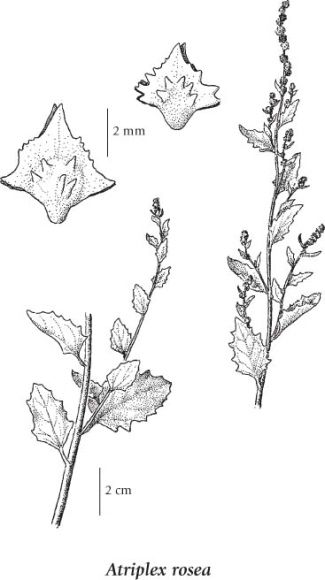Atriplex rosea L.
red orache (tumbling orache; tumbling saltweed)
Amaranthaceae (Amaranth family)
(Previously in Chenopodiaceae)
Introduction to Vascular Plants
red orache (tumbling orache; tumbling saltweed)
Amaranthaceae (Amaranth family)
(Previously in Chenopodiaceae)
Introduction to Vascular Plants
Species Information
General:
Annual herb from a taproot; stems erect, simple or freely branched, 0.2-1.2 m tall, nearly glabrous.
Leaves:
Lower leaves opposite, upper leaves alternate, stalked or stalkless, lanceolate to egg-shaped or nearly diamond-shaped, 2-5 cm long, generally slightly toothed, often blunt to rounded at the base, whitish-grey, covered with a copiously and permanently greyish-mealy substance, especially on the lower leaf surfaces, upper surfaces greenish, fleshy.
Flowers:
Inflorescence of terminal or axillary spikes or panicles; pistillate bracteoles lance-shaped to orbicular, strongly flattened, pointed at the tip, margins slightly toothed, the backs sharply pimply.
Fruits:
Membranous bladders enclosed by 2 lance-shaped bracts; seeds 2 mm long.
Illustration

If more than one illustration is available for a species (e.g., separate illustrations were provided for two subspecies) then links to the separate images will be provided below. Note that individual subspecies or varietal illustrations are not always available.
Illustration Source: The Illustrated Flora of British Columbia
Habitat and Range
Dry roadsides and disturbed areas in the steppe zone; rare in SC BC; introduced from Europe.Status Information
Taxonomic Notes
"The genus Atriplex, commonly called orache, atriplex or saltbush, of the family Chenopodiaceae (the goosefoot family), comprises nearly 200 species. The genus has a worldwide distribution, occurring on all continents except Antarctica. Most of the species are halophytes of coastal or inland saline habitats; a few are widespread ruderals of disturbed ground." (Bassett et al. 1983).
References Bassett, I. J., C. W. Crompton, J. McNeill and P. M. Taschereau. 1983. The genus Atriplex (Chenopodiaceae) in Canada. Monograph #31, Agriculture Canada, Ottawa. |
